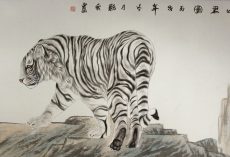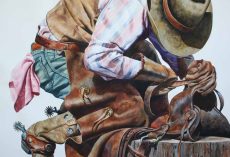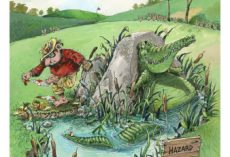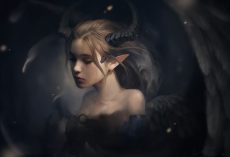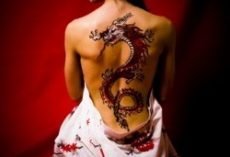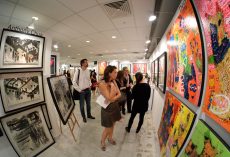What is ASCII Art?
Text Art has been around long before computers. It predates even typewriters.
ASCII Art is a form of text art. It is named so for the 95 printable characters defined by ASCII.
ASCII stands for American Standard Code for Information Interchange, it is a character encoding based on the English alphabet. ASCII codes represent text in computers, communications equipment, and other devices that work with text.
Most examples of ASCII art require a fixed-width font (non-proportional fonts, like on a traditional typewriter) such as Courier for presentation.
The ASCII character set
! ” # $ % & ‘ ( ) * + , – . / 0 1 2 3 4 5 6 7 8 9 : ; & l t ; = > ?
@ A B C D E F G H I J K L M N O P Q R S T U V W X Y Z [ \ ] ^ _
` a b c d e f g h i j k l m n o p q r s t u v w x y z { | } ~
Fixed width fonts versus proportionally spaced fonts
Fixed width font: Every character, symbol, and space occupies the exact same width.
Proportionally spaced font: A character’s width is defined by the amount of width needed to display that particular character.
Why are there proportionally spaced fonts?
The letter ‘i’ is, by its very nature, a narrow letter. It doesn’t require much width. The letter ‘m’, on the other hand, is rather wide. One could write three ‘i’s’ in the room it takes to display only one letter ‘m’. When you create a font that is proportionally spaced, it has a tendency to be much more pleasing to the eye.
Why are there fixed width fonts?
There are two reasons.
1. The typewriter. When the typewriter was invented it was, at the time, a fairly advanced piece of mechanical engineering. By pressing keys, a metal arm with an embossed letter would stamp an ink ribbon and produce the image of that letter on a piece of paper. Then the roller assembly that held that piece of paper would move to the left just a bit so the next letter that was typed wouldn’t go over top of the last. Instead it would be positioned just to the right of the previous letter. Since there was no way for it to know which letter was last typed, they had to decide on one fixed amount of space each letter would have. As a result, they had to design the letters in sucFonts with gridlinesh a way that they wouldn’t look silly all having the same amount of width. The letter ‘m’ gets squished and the letter ‘i’ has elongated serifs to make it appear wider.
2. What turned out to be a limitation of the typewriter actually turned out to be a useful tool in the computer age. Early computers did not display graphics. The screen was a grid of characters. The evenly spaced grid also employed a fixed width font. Programmers found this useful because they could plot the exact point on the screen where they wanted their character to appear. Fixed width fonts were employed for this scenario. You can still see this today; just open a DOS window on a Windows PC. A fixed width font will still be displayed. You can change the font used in a DOS window, but it only allows you select from fonts that are fixed width. When the Macintosh introduced the world to the graphical user interface, or GUI, it was no longer necessary to use fixed width fonts. And so was born the explosion of desktop publishing and WYSIWYG.
ASCII Art Links
An ASCII Art portrait of Seth Godin
An ASCII Art portrait of Seth Godin, creator of Squidoo and other amazing keyboard art pages of interesting people, celebrities and others of reknown.
Star Wars: ASCII Art-oo
Recreations of some of the most famous Star Wars ships, in ASCII. By Joe Reiss
Nerd Boy
The Adventures of Nerd Boy. An ASCII comic strip by Joaquim Gandara.
ASCII Cows
The canonical list of Ascii Cows.
ascii-art.com
ASCII art gallery by Joan Stark.
Popular Mechanics 1948
An article about “Keyboard Art” done with a typewriter in an October 1948 edition of Popular Mechanics.
While purely entertaining, doodling with a typewriter gives vent to the imagination and originality of both the experienced and the hunt-and-peck typist. Fill-in pictures are the easiest to “draw” with a typewriter. An example is shown in the flower which is made with the letter X alone. Such pictures, whether a flower or a portrait, are made by using an outline of the subject as a typing guide. This is done by tracing the outline lightly on paper and backing it with carbon paper to type the picture. Caricature or cartoon “drawing” combines letters with symbols as shown in the examples below. Here, half-spacing of the typewriter is required, as in the case of the owl’s beak and feet. The log cabin shows what can be done in drawing a picture in perspective.
Popular Science 1939
Typewriter Artist Produces Pictures Like Tapestry
Pictures that resemble tapestry are produced with a typewriter by Rosaire J. Belanger, a mill worker in Saco, Me. Belanger first draws a pencil sketch on a sheet of paper, then inserts it in his typewriter and fills in the sketch with various characters to produce shading and outlines. With carbon paper, he transfers the picture onto graph paper, and copies it on blank paper.
ASCII Babes
The worlds most beautiful celebrities like you’ve never seen them before.

